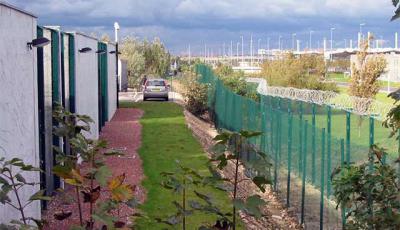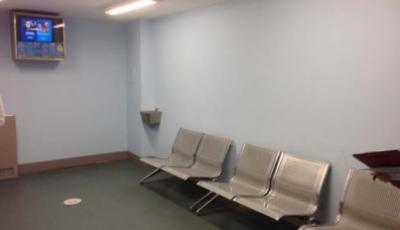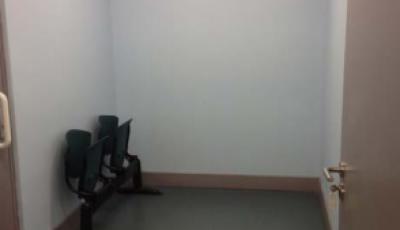Juxtaposed Border Controls and Penal Power on the French North Coast
Posted:
Time to read:
Post by Mary Bosworth, Director of Border Criminologies.
Introduction
While most of my work focuses on the experience of staff and detainees in the UK immigration detention system, I also study detention practices in France and Greece along with bordering practices further afield in Jamaica and Nigeria. In this post, I describe a current piece I’m writing on juxtaposed controls as it pertains to British Short Term Holding Facilities (STHFs) along the French north coast.

While attention is understandably focused on the encampments in Calais (see, for example, here) and Dunkerque, it’s important that we do not forget about the official sites of detention nearby run by the French and the British. Though tiny in comparison to the scale of the refugee camps, these sites and the juxtaposed controls that facilitate them are crucial to the logic and practice of border control in the region.
Offshore Detention
States around the globe often favour offshore border controls, usually, as Alison Mountz reminds us, on an island. It’s worth remembering that the original detention site on Guantanamo Bay, Cuba, for instance, was built by the US to house irregular immigrants away from the US mainland. Australia has been a particularly enthusiastic proponent of similar methods, opening, closing, and then opening again, detention sites in Nauru and Manus, well outside its territorial waters. Such sites are usually chosen for their legal exceptionalism. They are typically in the ‘global south,’ out of sight, and in countries where, usually, a financial arrangement can be made to keep the foreigners out.
Calais and Dunkerque don’t fit this model. Although ‘offshore’ they are not outside British or French law, but rather are officially governed through ‘juxtaposed controls.’ This legal arrangement, in which one nation state allows another to operate within its territorial border, as though it were not entirely sovereign, raises quite different issues to the more familiar ones posed by the island detentions.
Most obviously, the UK and France are of equal standing. France does not face the same financial imperative to do Britain’s border work as Nauru does in relation to Australia. What then leads them to host British detention sites, border guards, and police in their territory? What happens to those detained in such places? Whose legal and moral responsibility are they?
Juxtaposed controls have existed between France and the UK since 1994. Part of the Sangatte Protocol signed in 1991 to speed up entry and exit procedures on the Channel Tunnel route, these checkpoints were expanded in 2000 by ‘An additional protocol to the Sangatte Protocol’ that included all the main train stations on the Eurostar route from 2001. The sites expanded again in 2003 to include ferry ports, under the terms of the Treaty of Touquet which was put into effect by the Nationality, Immigration and Asylum Act 2002 (Juxtaposed Controls) Order 2003. Subsequent legislation and agreements have continued to tinker with their management, creating in 2010, for instance, a Joint Operational Coordination Centre in Calais to share information between the UK Border Force and the French border police.
Under the terms of these agreements, foreign border authorities in the areas governed by juxtaposed controls wield the same prerogatives as those they have in their home country. The British in France can stop, search, and detain individuals and freight vehicles while they are still on French soil. Although there is no French detention site in the UK, French border police are active on British territory near Dover, permitted to carry firearms, in contrast to the national practice of the overwhelming majority of British law enforcement.

The STHFs in France hold people heading towards Britain who have been identified by the UK Border Force staff checking freight, coaches, cars, and foot passengers. All are staffed by British detention custody officers who, like their colleagues in Immigration Removal Centres (IRCs) and STHFs in the UK, are employed by private custodial companies. They are overseen by local UK Border Force personnel who visit daily.
Information about daily life in these institutions is hard to come by. While they fall under the usual inspection regime of HMIP, they were not scrutinized between 2005 and 2012 due to ‘a lack of jurisdictional clarity.’ When the Contrôleur Général des Lieux de Privation de Liberté was created in France in 2008, it was agreed that the UK and French National Preventive Mechanisms would conduct a joint inspection of the facilities. In the 2012 joint report, it is noted that a similar holding facility was operating at Dunkerque and three UK police cells were discovered in the British controlled area above Coquelles Tourists (these were not inspected in 2012). Unlike residents in STHFs in Britain, those in France are neither visited by the IMB nor by a visitor group.
Like the STHFs in the UK mainland, these are sites of very brief detention, where most people will be held for less than 24 hours. The initial period can be extended for a further 24 hours after obtaining the consent of the (French) prosecutor of the high court (Tribunal de Grande Instance) which has been specially set up nearby as an outpost of the Tribunal in Boulogne-Sur-Mer for this purpose and for making decisions about detainees in the local French CRA in Coquelles.

austere and gloomy. They lacked the necessary facilities to hold detainees with dignity. The overall detention experience was poorer than in many other facilities that we inspect.
Nearly all detainees held in the STHFs are handed over to the French border police, Polices Aux Frontières (PAF) who, in turn, detain them in the French CRA in Coquelles. Governed by France’s strict rules on duration, which limit detention to a maximum of 45 days, but deal with most people far more quickly, these individuals are then, usually, released with an order to quite French territory. From there, they are likely to head to the encampments nearby.
Conclusion
While the explanations for these sites are primarily legal, reflecting the UK’s position outside Schengen as well as the canniness of British law-makers, they also flow from more mundane implications of international train travel and everyday aspects of running and securing ports. Their exclusionary effect is, as ever, deeply racialised.
In comparison to the life and struggle of the encampments, these bureaucratic waiting rooms are easily overlooked. The numbers passing through them are minimal. Their regimes are unremarkable. Yet, in their overlapping legal frameworks and in their governance arrangements these British detention sites on the French north coast reveal once again the malleable nature of administrative law and border control, its expansive and coercive reach. Like IRCs, we need to know far more about the nature of their administration, how their officers work the UK Border Force and with the PAF.
Criminologists have long argued that the purpose of incarceration is partly symbolic. In detention, this aspect is clearly amplified; these sites cannot hope and do not attempt to hold the sum of people who could be confined. The STHFs on the French north coast make this aspect quite clear. They have space for a mere handful of people. Yet, their presence is more than purely symbolic. These sites are made possible not just by emotions and fears about foreignness, but also by law. Juxtaposed controls exist in other jurisdictions, but have attracted little attention. Just as we need more fieldwork on the border, we also need more legal analysis of the rules underpinning and facilitating practices. Border control may, at its base, be a political decision, but it’s implemented in the law. These spaces of confinement in France show how far nation states are prepared to go together, to prevent others from entry.
Hopefully I will eventually gain access to them. If not, I will continue with the legal and documentary analysis. Once the piece is finished, I will return to Border Criminologies with an update. Activists and individuals are busy in Calais. Public personalities and MPs are as well. We need more academic scholarship on it too, to try to make sense of what is going on and identify alternatives.
Any comments about this post? Get in touch with us! Send us an email, or post a comment here or on Facebook. You can also tweet us.
__________
How to cite this blog post (Harvard style):
Bosworth, M. (2016) Juxtaposed Border Controls and Penal Power on the French North Coast. Available at: https://www.law.ox.ac.uk/research-subject-groups/centre-criminology/centreborder-criminologies/blog/2016/02/juxtaposed-border.








